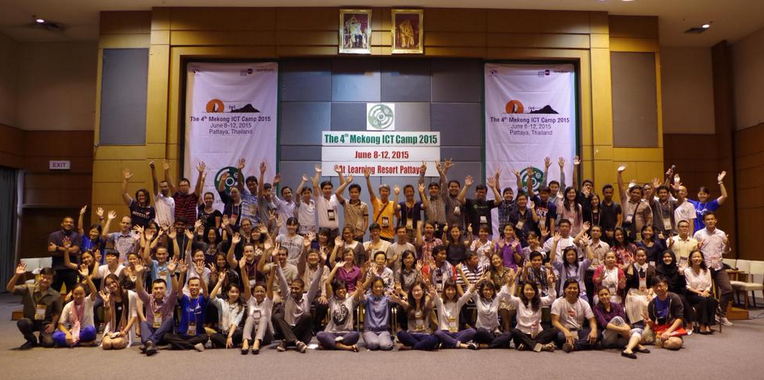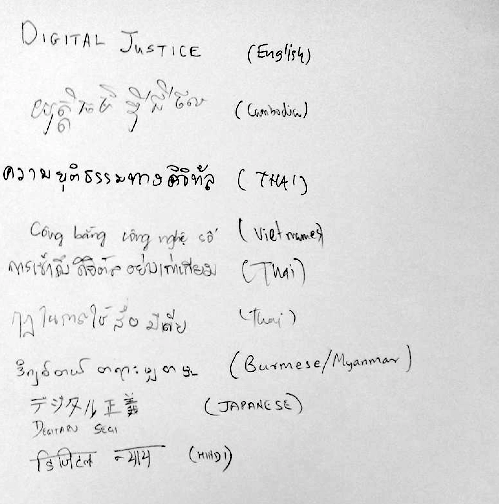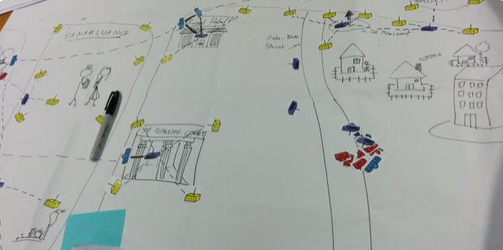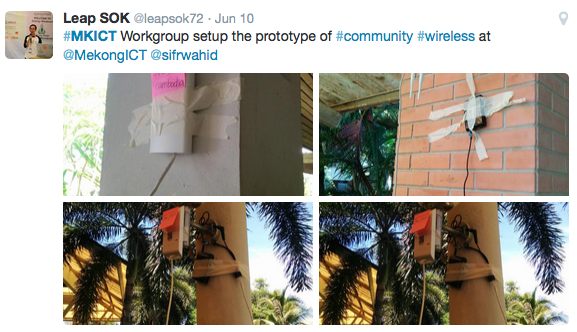OTI at Mekong ICT CamP 2015
Community Infrastructure and Digital Justice Workshop
Press Release

July 2, 2015

In June, the Thai Fund Foundation held the 4th annual Mekong ICT Camp, and convened over 75 journalists, social workers, rights activists, and academics from Cambodia, Laos, Vietnam, Cambodia, Myanmar, and Yunnan, China, for a five day training on information, communication and technology for citizen media, community health and civil society development in the Mekong region. Mekong ICT Camp 2015 had three major workshop tracks and a number of different sessions over the five days.
The Open Technology Institute facilitated a Community Infrastructure and Digital Justice workshop track and a two and a half hour session on Emergency Communications and Resilience. The workshop and session were co-facilitated by a Community Technologist from MojoLab Foundation in India.
In both the workshop track and the session, the goal was to share our methods of participatory design, teaching and facilitation, in addition to the technical substance. In many projects, the community organizing and facilitation are the most difficult components. What follows is a brief summary of the goals and activities in the track and session.
Summary: Community Infrastructure and Digital Justice Track
Time: 5 Days (~14 hours)
OTI’s workshop track introduced participants to the technical and social components of community-controlled infrastructure and community wireless networks. The concept of digital justice provided a foundation and motivation to the workshop, and connected the diverse array of participant skill sets, work and projects to a common theme.
The Community Infrastructure and Digital Justice track had the following overall goals:
Become familiar with the Detroit Digital Justice Coalition Digital Justice Principles, and explore how community-controlled communication systems, like community wireless networks, relate to those principles.
Learn about participatory mapping and the use of a common visual language to help all community members participate in designing technology projects.
Learn a basic wireless design skills.
Discuss sustainability, governance and outreach models for their potential projects.
Design a wireless network that will address a digital justice issue in a particular neighborhood or town.
Configure and install routers using Commotion.
Setup a small mesh network across the conference area, hosting local applications such as chat and a web server on a computer and a Raspberry Pi.
Activity 1: Digital Justice Principles
Participants in the Community Infrastructure and Digital Justice track began the track by exploring the Detroit Digital Justice Principles as a foundation for addressing digital disparities and engaging in technology-related projects. Participants read the principles and discussed how the principles relate to the work they are already doing. Participants defined the word Digital Justice in each of their languages.

Activity 2: Lessons and Reflections from Community Wireless Networks
Abhishek, a Community Technologist from MojoLab Foundation, spoke about the goals, challenges and future of the COWMesh network outside of Bangalore, India. Another participant shared their experience building and maintaining a community wireless network to connect remote villages in their country.

Activity 3: Imagining Community Technology
Each participant imagined and sketched a community technology project in their town or city. They were given the following questions to focus their design: Based on the digital justice principles, what kind of project would you imagine in your community? What could encourage locally created media? What would ensure all community members can participate? What would address a social justice issue in the community? After everyone finished, they took a few minutes to walk around the room and look at the ideas.
Activity 4: Participatory Network Design--Every Network Tells a Story
Breaking into groups, based on where people live, participants used Every Network Tells a Story to learn basic wireless design principles and design a community wireless network that would address a digital justice issue in that place. Later participants learned about network design approaches, including both mesh and traditional hierarchical networks--they learned the benefits and tradeoffs of the different designs.
Activity: Every Network Tells a Story


Activity 5: Flashing and Configuring Routers using Commotion
In small groups, participants learned how to configured routers with Commotion. In the process participants learned about open source router operating systems and the basic configuration settings of a wireless network (i.e. access point name, mesh name, channel, link encryption key, etc.). A few of the routers required “re-flashing” of their operating system, and participants with experience in open source router software were able to share their skills with the others.
Activity 6: Build a Small Pop-up Network
Participants went outside and surveyed the University Campus and identified potential sites for wireless connections. Participants then reconvened and build a 7 node network stretching across the campus, using battery powered routers where no power was available. A few of the participants eventually connected a Rasberry Pi webserver and an xmpp server to the network.
Activity: Build a Popup Network

Activity 7: Design Thinking Methodology
Facilitated by Chutika Prut Udosinn, founder of Good Factory in Bangkok, participants focused on prototyping solutions related the social justice issues they identified. Participants in the Community Infrastructure track defined local network services and methods for their community wireless networks that would address their identified issue.
Activity 8: Sustainability, Governance and Community Outreach
At the end of the workshop, the group discussed the difficult issues around funding, governance and community outreach. We brainstormed different methods around each of these issues, and the result is an impressive collection of ideas that applies to any community project, summarized here:
Fundraising and financial sustainability models? Crowd sourcing, donations from residents living outside the country or in the capital, charge small fee to each user, donations from users, buy-your-own-router, sell routers to businesses or organizations at higher cost to subsidize cost to others.
How are decisions made? Who participates in decision making? Voting and discussion in community meetings, online/offline decision platforms, coalitions of stakeholders, coalition of civil society organizations, representative group of decision makers.
How to start the community involvement process? Listen, share food, talk with community leaders/elders, hold a community-wide meeting, talk with community organizations, start by helping with another project.
Summary: Resilience and Emergency Communication
Time: 2.5 hours
The Resilience and Emergency Communications session provided a space for participants to examine the ways communities self-organize information exchange and communication during emergencies.
The goals for the Resilience and Emergency Communication session were:
Explore the layers of no-tech, low-tech and high-tech methods communities can use to communicate information during a disaster, discussing the potential uses and limitations of each of the methods.
Develop a basic, shared understanding of the skills, infrastructure, procedures and practices that need to be in place before a disaster in order for the community to be more resilient. Explore methods of strengthening this underlying foundation before an emergency occurs.
Understand the opportunities and challenges of the participant-created local area wireless mesh network allowing for resilient, autonomous communication.
Activity 1: Communication Methods Brainstorm
Brainstorm all the non-tech, low-tech and high-tech ways people in one area can distribute information during an emergency. Information exchange methods included: bullhorn, speakers mounted to a car, loudspeakers, graffiti, posters, usb drives, centralized computer, mirrors on rooftops, bells, whistles, face-to-face, writing on sidewalks, flyers, posters, community radio, amateur or HAM radio, etc.

Activity 1b: Reflect on these Methods in Your Place
Each participant drew how these methods might be used to provide robust information exchange in their own neighborhood or town. Participants then walked around the room to see what others had designed.
Activity 2: Analyzing Methods
The group then synthesized the strengths and weaknesses of all of the methods, identifying the following dimensions:
Distance: how far can you transmit information?
Number of people: how many people can you reach?
Complexity of use: is it difficult or easy to use and setup?
Cost: expensive or cheap?
Inclusive: who will have access? who will not have access?
Bandwidth: can you provide a lot or a little information at a time?
Reliability: does it require power?
Activity 3: Defining Resilience
Together the group defined fundamental components of a resilient community, and then identified processes or elements that build those components, briefly summarized here:
Basic Infrastructure: community center, computer lab, local area network, local cellular provider or ISP, community radio station, solar panels, other equipment.
Skills and expertise: trainings, classes, knowledge exchange, library.
Protocols and plans: established action plans, which include roles, meeting points, plans for vulnerable populations, etc.
Cohesiveness and organizing capacity: civil society organizations, regular community meetings, frequent community activities.
Activity 4: What Can We Do?
Individually, participants answered the following question: in your neighborhood or town what are three concrete things you could work on to make your community more resilient during and after an emergency?
The session ended with a walking tour of the popup mesh network setup by participants of the Community Infrastructure track. Session participants discussed the challenges and opportunities of autonomous networks for communication during an emergency.